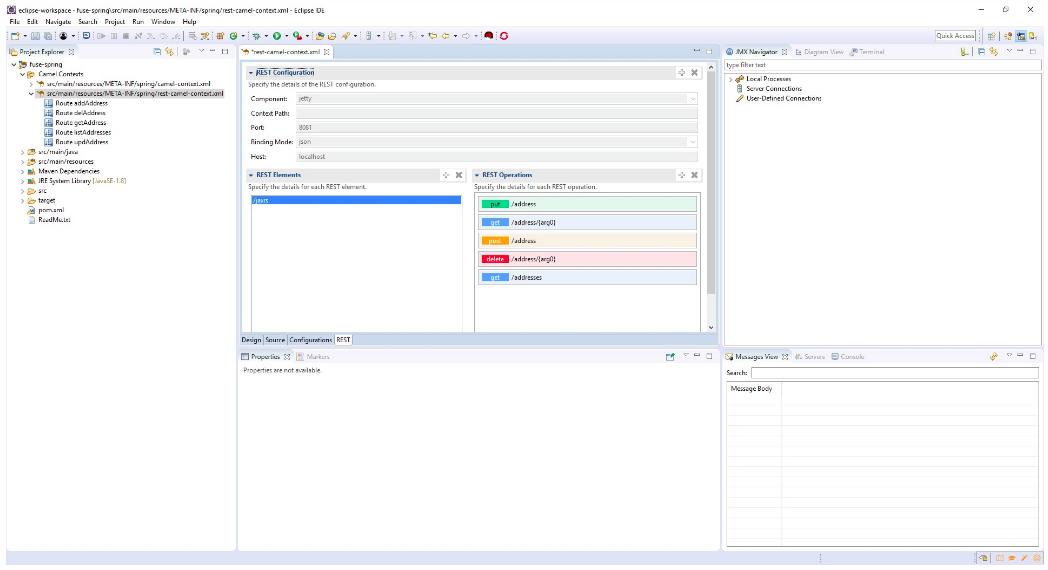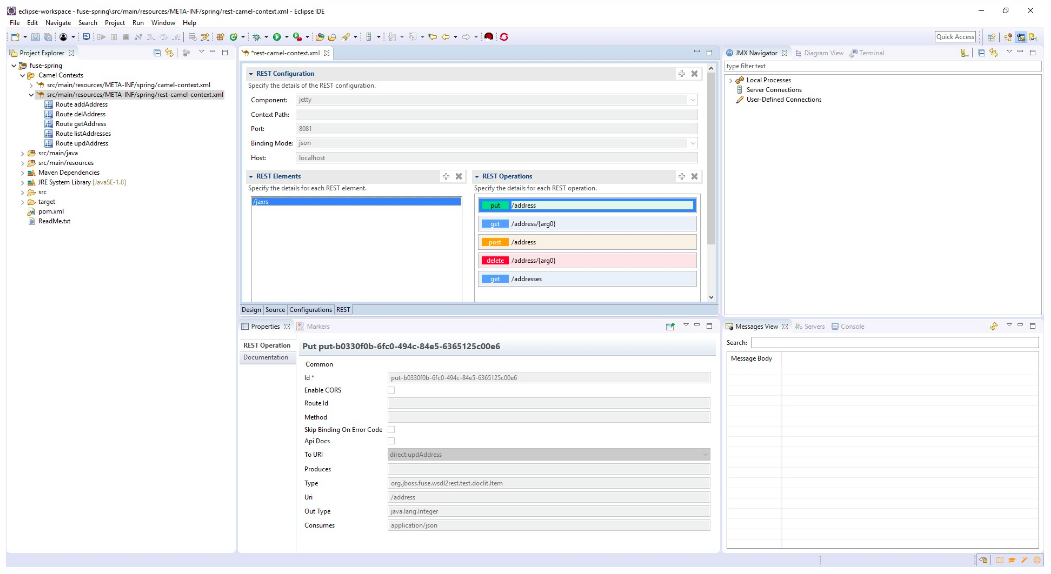此内容没有您所选择的语言版本。
Chapter 2. Release Notes
2.1. Forge Tools
2.1.1. Forge Runtime updated to 3.9.0.Final
The included Forge runtime is now 3.9.0.Final. Read the official announcement here.
2.2. Fuse Tooling
2.2.1. Camel Rest DSL from WSDL Wizard
The new Camel Rest DSL from WSDL wizard wraps the wsdl2rest tool that is now included with the Fuse 7 distribution. This tool takes a WSDL file for a SOAP-based (JAX-WS) web service and generates a combination of CXF-generated code and a Camel REST DSL route to make it accessible using REST operations.
To start, you need an existing Fuse Integration project in your workspace and access to the WSDL for the SOAP service. Then use the File > New > Other menu and select Red Hat Fuse > Camel Rest DSL from the WSDL wizard.
On the first page of the wizard, select your WSDL and the Fuse Integration project in which you want to generate the Java code and Camel configuration.
Figure 2.1. Selecting the WSDL and Fuse Integration Project
You can customize the Java folder path for your generated classes, the folder for the generated Camel file, and any customization for the SOAP service address and destination REST service address.
Figure 2.2. Specifying the Advanced Options for wsdl2rest Processing
Click Finish to generate the new Camel configuration and the associated Java code in your project. The wizard determines whether your project is Blueprint, Spring, or Spring Boot based, and it creates the corresponding artifacts without requiring any additional input. When the wizard is completed, you can open your new Camel file in the Fuse Tooling Route Editor to view its content.
Figure 2.3. Viewing the Camel File Content
2.2.2. Camel Editor REST Tab
The Fuse Tooling Route Editor provides a new REST tab. For this release, the contents of this tab are read-only and include the following information:
- Details for the REST Configuration element including the component (jetty, netty, servlet, etc.), the context path, the port, binding mode (JSON, XML, etc.), and host. There is only one REST Configuration element.
A list of REST elements that collect REST operations. A configuration can have more than one REST element. Each REST element has an associated property page that displays additional details such as the path and the data it consumes or produces.
Figure 2.4. List of REST Elements that Collect REST Operations
A list of REST operations for the selected REST element. Each of the operations has an associated property page that provides details such as the URI and output type.
Figure 2.5. List of REST Operations for the Selected REST Element
For this release, the REST tab is read-only. If you want to edit the REST DSL, use the Route Editor Source tab. When you make changes and save them in the Source tab, the REST tab refreshes to show your updates.
2.2.3. Camel URI Completion with XML DSL
It was possible to have Camel URI completion with XML DSL in the Source tab of the Camel Route editor by installing the Language Support for Apache Camel in your IDE.
This feature is now installed by default with Fuse Tooling. To view the feature in action, refer to https://tools.stage.jboss.org/documentation/whatsnew/fusetools/images/completionSourceEditor.gif.
Depending on your development preference, you can now use the Properties view with UI help to configure Camel components or use the source editor and benefit from completion features.
2.3. Maven
2.3.1. Maven Support Updated to M2E 1.9.1
The Maven support is based on Eclipse M2E 1.9.1, bringing the following features:
- Advanced classpath isolation: Due to Eclipse Photon, two new classpathes are now available: the main and the test classpath. The main classes will now no longer see the test classes and dependencies.
- Embedded Maven runtime: The embedded Maven runtime is now based on Apache Maven 3.5.3.
- Archetype catalog management: It is now possible to disable an archetype catalog.
- Java 9/10 support: Support for Java 9/10 has been improved: bugs fixes, better handling of module path.
2.4. OpenShift
2.4.1. Enhanced Spring Boot Support for Server Adapter
Spring Boot runtime was already supported by the OpenShift server adapter. One of its major limitation has now been fixed. The limitation was that files and resources were synchronized between the local workstation and the remote pod(s) only for the main project. If your Spring Boot application had dependencies that were present in the local workspace, any changes to a file or resource of one of these dependencies was not handled.
Related JIRA: JBIDE-25504
2.5. Server Tools
2.5.1. Wildfly 13 Server Adapter
A server adapter has been added to work with Wildfly 13. It adds support for Servlet 4.0.
Related JIRA: JBIDE-26071
2.6. Web Services Tools
2.6.1. JAX-RS 2.1 Support
JAX-RS 2.1 is part of JavaEE8 and JBoss Tools now provides you with support for this update of the specification.
2.6.2. Server Side Events
JAX-RS 2.1 brought support for server side events. The Sse and SseEventSink resources can now be injected into the method arguments, thanks to the @Context annotation.
Related JIRA: JBIDE-26040




